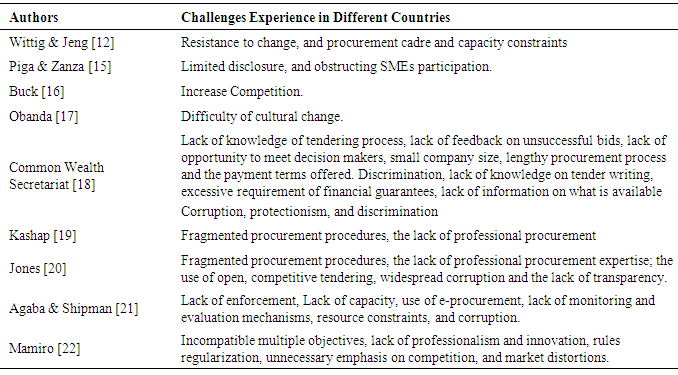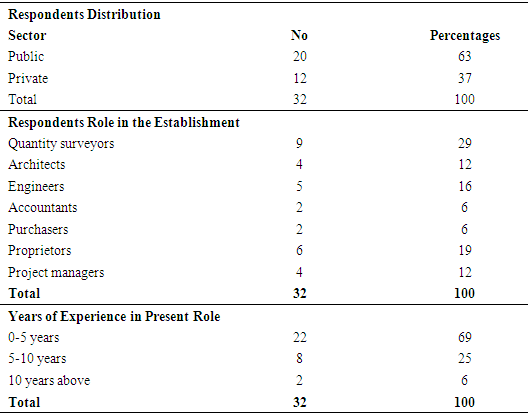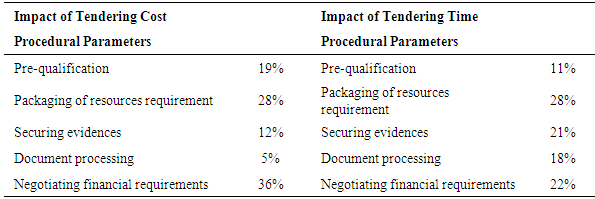-
Paper Information
- Previous Paper
- Paper Submission
-
Journal Information
- About This Journal
- Editorial Board
- Current Issue
- Archive
- Author Guidelines
- Contact Us
International Journal of Construction Engineering and Management
p-ISSN: 2326-1080 e-ISSN: 2326-1102
2015; 4(5): 201-209
doi:10.5923/j.ijcem.20150405.05
Assessment of Procedural Parameters for Improving Public Procurement Practice in Nigeria
Samuel Ekung1, Adeniran Lashinde2, Ogochukwu Amuda1
1Department of Quantity Surveying, Imo State University, Owerri, Nigeria
2Department of Quantity Surveying, University of Uyo, Uyo, Nigeria
Correspondence to: Samuel Ekung, Department of Quantity Surveying, Imo State University, Owerri, Nigeria.
| Email: |  |
Copyright © 2015 Scientific & Academic Publishing. All Rights Reserved.
This study examined procedural and administrative impediments in public procurement practice in Nigeria. The objective was to assess procurement procedures that can be improved for increased efficiency within the existing guidelines. It was an exploratory research employing questionnaire survey administered to procurement stakeholders in two Federal institutions in Akwa Ibom State, Nigeria. The stakeholders include procurement administrators, built environment professionals and contractors. Data analyses involved descriptive statistics and inter rater agreement. The study found that administrative procedures are cumbersome under existing guidelines and requires improvements. These procurement procedures include activities such as verification of evidence, appraisal of submissions, handling of documents, continuous pre-qualification, and handling of request for information. The study settled that the use of self-declaration form, suspension of documental evidences’ verification, focus on suitable bid and e-submissions will significantly improve public procurement practice in Nigeria. However, the level of knowledge of these parameters among the population studied is very low. The low level of knowledge suggests the need for training notably in information and communication technology. With these findings, stakeholders in public procurement can now relieve administrative burdens and fast track public work processes using the improvement parameters identified.
Keywords: Administrative burden, Nigeria, Procedural parameters, Public procurement, Public procurement act
Cite this paper: Samuel Ekung, Adeniran Lashinde, Ogochukwu Amuda, Assessment of Procedural Parameters for Improving Public Procurement Practice in Nigeria, International Journal of Construction Engineering and Management , Vol. 4 No. 5, 2015, pp. 201-209. doi: 10.5923/j.ijcem.20150405.05.
Article Outline
1. Introduction
- Public procurement reform in Nigeria started early 2000 with the establishment of Budget Monitoring and Price Intelligent Unit (BMPIU). Before this time, the public procurement in Nigeria was characterized by process abuse, lack of transparency, inflation of contract costs, and influence peddling [1]. These problems gave rise to project abandonment, delay and low standard of project delivery [2]. The drive for improve practice was sustained and culminated in the enactment of Public Procurement Act (PPA) 2007. The PPA was received by all stakeholders as a child of necessity by relevant stakeholders including professionals in the construction industry, civil liberty organisations and public institutions. Like other decision-making framework, the PPA was received with mix feelings in some quarters notably professionals bodies that were consulted [2]. The importance of multi-level, multi-sector consultation at the inception of a procurement regime has been acknowledged [3]. The purpose of the PPA was to set out guidelines for the regulation of public procurement in Nigeria with an overall objective of enthroning rule of law, transparency, and accountability. These performance objectives were hitherto lacking in the system. Years into implementation, PPA seems to have made engineered savings in contract awarding processes in Nigeria [1, 4] Despite its relative success, there are emerging concerns arising from inherent lacunas. These lapses constitute pockets of challenges to efficient public infrastructure procurement. The procuring community globally is faced with differing magnitude of challenges [5]. The most prominent challenge with the public procurement practice in developing countries is confirmation bias. This problem is procedure based. The term is use to describe a situation in which parties or procuring entities attach importance to weighted information, evidences and arguments than the outputs [6]. Literature also identifies the preference for joint assessment as factor responsible for poor performance of the system. It is argued therefore that when people opt to a different procedure in evaluating suitable offer, tendency subsists that varying preferences would be benchmarked. Another explanation offered in the literature utilised what is termed the halo effect. By the halo effect, psychologists explained that people tend to focus on the external characteristics of the subject they are evaluating than its inherent functionality. In procurement terms, when organisations set up criteria to evaluate suppliers suitability externally without due diligence to confirm its true state with underperforming outcome, halo effect is established. Due to these challenges, the global community is engrossed in exploring improvements. An area of the public procurement practice that the research community have done very little is in exploring mechanisms to cut-out administrative impediments within the system. The need to improve public works efficiency through the reduction of administrative procedures had been canvassed by [7]. The research focus in this area is not relatively recent [8]; but the attention of the various studies in the continental Europe and the UK focused on how to improve the participation of the small and medium scale enterprises only. Others focus on exploring best procurement strategy for effective project delivery. Only recently however, there is a growing emphasis on improving efficiency in view to guarantee best outcome in terms of quality and price. Such simplification is necessary in order to improve the regulatory guidelines. The developed nations are however not cut-out of these problems as there a handful of administrative issues bedevilling their public procurement practices [5]. The goal of this study is directed towards transforming public procurement practice in Nigeria into a veritable tool for meeting public works delivery needs. The objective is to assess procedural parameters that can be improved for increase efficiency within the Nigerian public procurement guidelines. To achieve the objective of the study, in-depth evaluation of extant literature in public procurement research globally and nationally was undertaken, procedural parameters are identified and validated using empirical data.
1.1. Challenges Facing Public Procurement
- The term public procurement has been variously defined. The most widely context focuses on the organisation, work load, and the normative view that is, what it is and what it shouldn’t be [9]. The definition ambiguity is due to miscommunication, lack of professional recognition and the inability to create a trained workforce. The term is widely adopted to describe the government’s activity of purchasing the goods and services which is needs to carry out its functions [10]. The definition in this context however needs reconsideration to buttress its rule based nature. This stems from the basis that all government acquisitions are regulated by a set of rules. Public procurement involves three major processes: procurement planning (deciding what to procure and when to do so); contract process (deciding the contracting partner and defining terms of contracts and procedure) and monitoring to ensure performance effectiveness [11]. However, there is an extended purview based on the United States’ Congress services Acquisition Reform Act which includes contract performance and contract financing. The basic objectives of public procurement rules are to ensure accountability, integrity, transparency and value for money. The need for public procurement reform became pronounced as the world procuring capital is becoming scarce. The impacts of scarce resources prompt the drive towards deregulation to enhance private sector participation in key sectors. But the reforms in most of these places are coercive; being an import from other places and does not therefore carter for the inherent needs of the new place. It therefore fails to allow for in-country peculiar procurement circumstance. Wittig & Jeng [12] points to external pressure mounted by donor agencies and organisations as a major cause of such undomesticated adoption. Yet, public procurement in developing countries remains at the centre of severe criticism and examination. Too often, in a quest to satisfy the demand for transparency and accountability, wrong persons are engaged to transact a mutually inclusive business from individual’s ends rather than mutually agreeing ways to achieve best results. Experts are told what to do and are not giving the opportunity to solve problems pragmatically [13]. The need for prudency in the management of public funds has also negatively impacted on the performance of projects by imposing the lowest bid rule bias [6]. Resistance to the use of in-country procurement guidelines has also been criticized [12]. Wide range development in technology, globalization and international trade charters have also compelled nations and public institutions to extend reform interest towards pursuance of innovation, global competitiveness and transparency [11].The public procurement guidelines in Nigeria has been criticized for involving a lot of man-hour yet with possible result in futility not for the lack of adherence, but because authority can unitarily decide to cancel process on account of public interest [2]. Thai [11] identified a range of environmental issues bordering on market, legal political, organisational, socio- economical and other factors. Erridge [14] identified three sets of conflicting objectives in which the efficacy of public procurement can be evaluated: regulatory; commercial; and socio-economic goals. The regulatory objective focused on the need to meet global best practice in promoting accountability, transparency and competition. In Erridge’s perspective, these objectives provide three mechanisms: open; restricted; and negotiated procedures in the selection of contractors. The commercial objective emphasizes the use of market mechanisms such as market testing and Private Finance Initiatives to achieve public procurement goals. The socio-economic objective on the other hand, focuses on the need for public procurement to pursue and support wider government policies that will improve social welfare of the citizenry. Policy areas in this regard include employment, economic development and environmental policy. Every public sector in the global world faces conflicting demand of satisfying these objectives [14]. There are conflicts between regulatory and commercial goal, regulatory and socio-economic and commercial and socio-economic objectives. Table 1 is a matrix of global perspective on problems associated with public procurement.
|
2. Procedural Parameters for Improving Public Procurement
- To improve regulatory framework, literature advocates the introduction of contemporary regulations to benefit contracting parties and the overall economy [23]. Contracting parties need a simplified regulatory framework to work with. Such policy will help to eliminate irrelevant cost burden on businesses [24]. The practice has been widely adopted and used across Europe. Vilarejo-Galende [8], reports that the simplification procedure was adopted by the European Initiative in 1998 to engender global competitive environment. The procedure simplification paved way for enhanced participation of small and medium scale enterprises and since then, many of such reforms have been implemented across Europe. Specific practices include coordinated award procedure to enhance effective competition; and reduced documentation requirement. As seen in the review in the foregoing review, it is widely reported that current practice in Nigeria and in global perspective is extremely rigorous and do not allow contracting organisations to negotiate with preferred bidders. Another issue in the rule simplification requirement is information disclosure. The inability to access project information and the lack of obligation to provide detailed information as when required is seen as a barrier to many potential bidders in Nigeria [25]. To provide an effective bid, a firm needs a comprehensive understanding of inherent risks to develop appropriate decision making strategy combined with the state of nature analysis to derive an effective bid [26]. The state of nature complication is a circumstance outside the control of the firm and therefore requires sufficient information for improved decision making. According to the Bayesian theory, decision making under risk can be improved and the state of nature understood if sufficient information are gathered about the market. Furthermore, information disclosure will enhance the efficiency of procurement outcome both in qualitative terms and price [23].There is need to encourage greater use of negotiated procedure. Construction cost is not a spare accessible from shelf like every day goods. Best prices are obtained from the interaction in the market place between the contracting entity and the supplier in a negotiated process. Continuous use of lowest bid criteria shut the door against effective bid procurement. The low bid syndrome has been widely criticized both in practice and in academic research reflections. Dekel & Schurr [6] and Waara & Bröchner [27] found a significant correlation between lowest bid and failure of construction projects. It is one of the leading causes of cost and time overrun in construction projects in Nigeria [28]. In traditional procurement practice, the buyer uses the contract to control the supplier [29]. The prices of the supplier is bargained a forehand thereby maximising the risk to every party [30]. The buyer tells the supplier what to do, how and when to do it. Kashiwagi [31] identified three possible outcomes with this arrangement: no supplier has been able to control another firm to enhance quality; a non-expert client directing an expert consultant and contractor thereby resulting in a reactive compulsion of the client to mitigate the risks; and confusion over contractual terms are imminent, and when it does litigation eschew. When these eschew, lose-lose endeavour result. Kashiwagi, Kashiwagi, Smithwick & Kashiwagi, [13] therefore proposed the re-organisation of the traditional procurement model. The recent refinement on extant practice incorporate such premise as: reduced competition [32]; the need to minimise clients control of the suppliers [25] the best being best value at lowest- price is win-win [13]; decision making under risk [26]; transparent contractual environment; joint risk management, and early contractors’ involvement amongst others. There is need to also introduce greater flexibility into contracting procedures. This will empower contracting authorities to negotiate the contractual requirements with potential suppliers or contractors. But there are impediment to watch out for, non-discrimination and equality. Greater use of negotiation is linked to increase favouritism risk and subjective decision making. To safe guard public interest against this risk, Gimeno Feliú [7] recommends the use of an independent organisation instead of a politically instituted body. In Nigeria, the contract awarding body remains Federal Executive Council. This is in deviant to the requirement of PPA. PPA stipulates the constitution of National Council for Public Contracts. Other improvement views canvassed in the literature encourages greater use of electronic process as a point of reference. Gimeno-Feliú and María [23] linked the efficiency of the proposed improvement on the technical experience of the contracting parties, level of information and knowledge possessed about the exchange place, and negotiating skills to enter into viable contract. To reduce procedural barriers associated with documentation at the pre-tender stages in public procurement, European Directive had canvassed the use of self-declarations, abolition of requirement to presents certificates and documental evidence, minimising administrative checks and e-submissions. The applicability of these parameters in Nigeria is tested using respondent perceptions.
3. Research Methodology
- Based on the need to improve innovations which is dearth in public procurement practice in developing nations [22, 33], an exploratory research was best suited. The exploratory study appraised the perception of procurement managers, built environment professionals and contractors in two Federal Institutions in Akwa Ibom State, Nigeria. The first institution is educational and the second, a health Institution. To achieve the objective of the study, questionnaire survey was employed. The questionnaire was administered to the respondents engaged in these institutions. The combined population of the study comprised of people engaged in the Physical Planning Unit of these Institutions and their Directors. The respondents include quantity surveyors, architect, estate surveyors, engineers, accountants, economists and other management science specialists. The requirement to sample these institutions is to satisfy the need that, the respondents studied are familiar with and implements the guidelines of the PPA. The decision was derived after a preliminary inquiry and participation in a bidding processes by one of the author. These institutions maintain clear records of strict adherence as a federal institution engaging the services of stakeholders across the different parts of the country. The population of study is in two layers, procurement administrators and their participating contractors. To determine the sample size each category, a preliminary inquiry was conducted on the two institutions. The preliminary inquiry revealed there are 26 personnel associated with the administration of procurement processes. There are also a total of 228 contractors registered to carry-out public works in three categories (small and minor works, medium, and large sized projects). Further inquiry into the willingness of the contractors to participate in the study shows only 112 ready and willing to provide requisite information. The study involved a purposive sample of 138 professionals, company directors and public procurement managers. This sample was randomly administered with the study questionnaire employing mainly self-administration and e-mail. Self-administration covered about 80% of the entire survey and 20% e-mailing. The combined approach was relatively successful, and yielded a response rate of 23%. The questionnaire comprised of nine questions. One to three elicits background information of the respondents: their organisation, years of experience and professions. Question 4 and 5 determined the level of inefficiency associated with procedural rules and guidelines set out in the PPA. Question 6 and 7 tested six procedural issues associated with public procurement. It involved rating with likert scale. The scale was defined as 1, being the least and 5, the highest level of severity. Validation of the scale and the adequacy of the data collection instruments were conducted using Alpha-Cranach test. The test yielded alpha Cronbach value of 0.76 and this is an indication of high consistency and adequacy. Question 8 examined the impact of procedural issues on procurement cost and time to the contractors. Question 9 examined the level of knowledge and the level of use of identified administrative procedures improvement parameters.Data analysis involved percentages, mean item score and inter rater agreement scale. Percentages were employed in analyzing descriptive data of respondents and impact of procedural issues on time and cost. Mean score evaluates the severity of procedural issues, Inter-rater Agreement scale was used to evaluate the level of consensus in respondents rating opinion.
4. Results
- The distribution of the study’s population is a representation of all participants from the practices studied. Table 2 presents data relating to respondents distribution and responsibility in their various organisations. The sample consists of 63% procurement administrators and 37% contractors. This distribution is homogenous and significant; the high procurement administrators’ participation gives impetus to the study’s subject on inherent procedural impediments in PPA. The quantity surveyors retains the highest proportion within the study sample; proprietors and owners of contracting businesses (19%), engineers (16%) architects and project managers (24%). Others include accountant and purchasing officers (6%). These arrays of professionals represent a sufficient mix with knowledge of procurement matters. Over 60% of the study’s sample have years of experience below 5 in the present role and above 5 years (31%). This reflects trend in the procurement practice in Nigeria in which full procurement unit emerged only recently, post 2007. The respondents’ roles, profession mix and their years of experience are significant parameters that can be used to evaluate the perception expressed by the respondents.
|
4.1. The Level of Adherence to Procedural Rules
- The study determined the level of use of procedural rules in public procurement practice. The result is shown in Fig. 1. Three levels of use are identified; yes always; rarely use; and not used. The level of use in each organisation is segregated. Fig 1 depicts the level of use in the health institution and 2; academic institution. Both institutions recorded a significant level of use of procedural rules. Use always and use rarely response is 91%. The implication is that within a year, 91% of the procurement needs of the institutions are based on the guidelines of the PPA.The continuous use of procedural rules strongly impedes the success rate of tenders and information disclosure. Information disclosure is a significant determinant of quality of bid submitted by a firm. The information disclosure in public procurement practice in Nigeria is low by 25% and low (56%). The combine opinion with low information disclosure is 81%. As a result of these prevailing practices, the success ratio is very low. Within the study sample, in every ten project bids, only 13% are successful that is 1 in 10 projects. A significant proportion of 87% of procurement efforts failed or are unsuccessful that is, 0 in 10 projects (Fig 2). The results point to the need to improve procedural parameters.
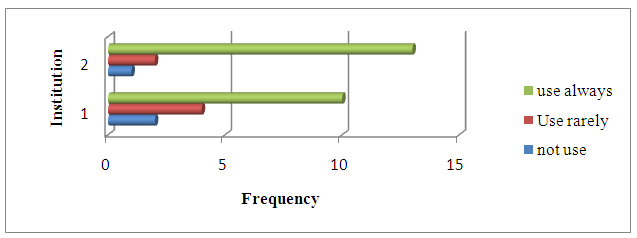 | Figure 1. Use of Procedural Rules |
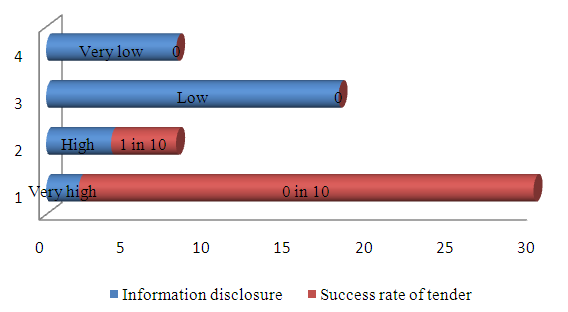 | Figure 2. Influence of Procedural Barriers on Success Rate/Information Disclosure |
|
|
|
|
5. Discussions
- Based on the results in Fig 1 and 2, the first procedural hitch identified in the study is the low level of use of negotiated procedure. The use of negotiated procedure involves contracting entities selecting viable economic suppliers of their choice and conferencing the terms of the contract that is subsequently awarded to them. This requirement is not possible when open and constrained procedures are used. The use of public procurement guidelines globally is characterised by open and restricted rules. To enhance the use of negotiated procedures in developing countries, skill development is essential, outright departure from extant practice to embrace collaborative forms of procurement is strongly necessary. Proper protections and securities must be guaranteed without jettisoning the requirement for transparency and accountability. One way to achieve the use of negotiated procedure is to ensure that notice of preliminary inquiries clearly stipulates the procurement strategy and the minimum requirement to be met. This is a front-end issue that can improve the decision to participate by economic suppliers. One of the key strategies to enhancing negotiated procedure is the use of information disclosure in an unbiased way. The objective is to eliminate asymmetric information disclosure that may prejudice the process, thereby giving an undue advantage to favoured suppliers than others. Another aspect of the procedural parameters examined in the study is documentation burdens. Three parameters are identified in the study to overcome these excessive documental requirements in public procurement practice. The first of the improvement parameters is self-declaration evidence. This document is a form of an affidavit required to be submitted at the outset of the selection process by suppliers to attest to their suitability to undertake the work. In this way, the supplier is not obligated to submit further documents and the contracting authority can confirm through official channel, and only selected suppliers would have to submit detailed documents. From the foregoing, it is apparent that this procedure does not prejudice compliance to the guidelines but only postpone the process and save pre-qualification costs to the suppliers’ organisations. Further refinement is the suspension of requirement to submit certificates and other documental evidence. One way to achieve this is to retain suppliers who have previously submitted these documents to the contracting authority. The referenced submittals suffice for fresh submission provided they are still valid. The next bottom neck though not a requirement from the supplier but the contracting authority is the need to reduce administrative check. This burden consumes useful time in an environment where procurement is carried-out by non-technical personnel. The use of information technology has significantly reduced administrative burden and bridges the interface created by submissions making. This view point received a low rating; and is an indication of improvement. Data bases of procuring entities are independently being linked and upgraded to web medium but not integrated. The lack of integration means residual oversight burden to the supervisory bodies. E-submission is not used within the public sector studied. Despite its efficiency, there are residual problems that impede the system thereby creating litigious problems that remains largely undetermined. Interoperability is known with every platform that is accessible from different domains and locations. The level of use of information technology even in the general construction practice in Nigeria is significantly low [34]. The most recent study on the level of information technology use within the construction sector in Nigeria, Ibironke, Ekundayo & Awodele [35] revealed a pathetic development, which is reluctant to embrace information technology use. It is the view of this study that the use of e-submission within public procurement practice is feasible given the relative successes in the private sector such as multi-national oil companies. This study suggest that to improve procedural bottom neck in the public procurement practice in Nigeria, efforts should be directed toward greater use of negotiated procedure, encourage self-declaration, greater use of e-procurement notably e-submission, e-certificates and self-certification
6. Conclusions
- Public procurement practice globally is faced with numerous challenges. In tackling these problems, developed nations are embracing improvements by entrenching flexibility in their procurement law. Flexibility is lacking in the procurement regimes of developing countries such as Nigeria as rigid guidelines are enforced. To seek improvement to extant procurement regime, this study assessed procedural parameters for improving public procurement practice in Nigeria. Using survey research design, the administrative procedures that can be improved for increase efficiency within the PPA was assessed. The findings of the study revealed the administrative procedures that require improvements are documentation and the lack of information disclosure. These procedures received very strong agreement rating on the inter rater agreement scale. The documentation requirements in the procurement practice are verification of evidence, appraisal of submissions, handling of documents, continuous pre-qualification, and handling of request for information. To overcome these impediments, the study validated four parameters namely: self-declaration form; suspension of documental evidences; focus on suitable bid; and e-submissions. The extent of knowledge of these parameters among the population studied is very low except focus on suitable bid. To improve procedural efficiency in public procurement, the incorporation of these parameters is advocated. Despite the current practice and the low level of knowledge of the improvement parameters, it is believed that their uses will significantly improve public procurement practice in Nigeria. The findings of the study present perspectives for tailoring future refinements in the reform of public procurement policy by the relevant stakeholders. Stakeholders in public procurement can now relieve administrative burdens and fast track public work processes using the improvement parameters identified. The study further provides insightful research question to be explored in the areas of determining the appropriate frameworks for entrenching these parameters within extant procurement regimes in developing countries.Despite these results, the study focused on the procurement experience of two public organisations using designed questionnaire survey instrument. To improve on the study’s finding, further studies may consider industry wide survey involving multiple institutions. Instrument design mixed approach may also facilitate the generation of other procedural difficulties encountered. Further studies may also wish to model cost/time impacts of procedural difficulties.
 Abstract
Abstract Reference
Reference Full-Text PDF
Full-Text PDF Full-text HTML
Full-text HTML